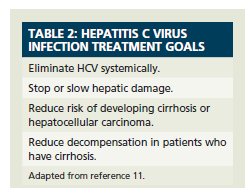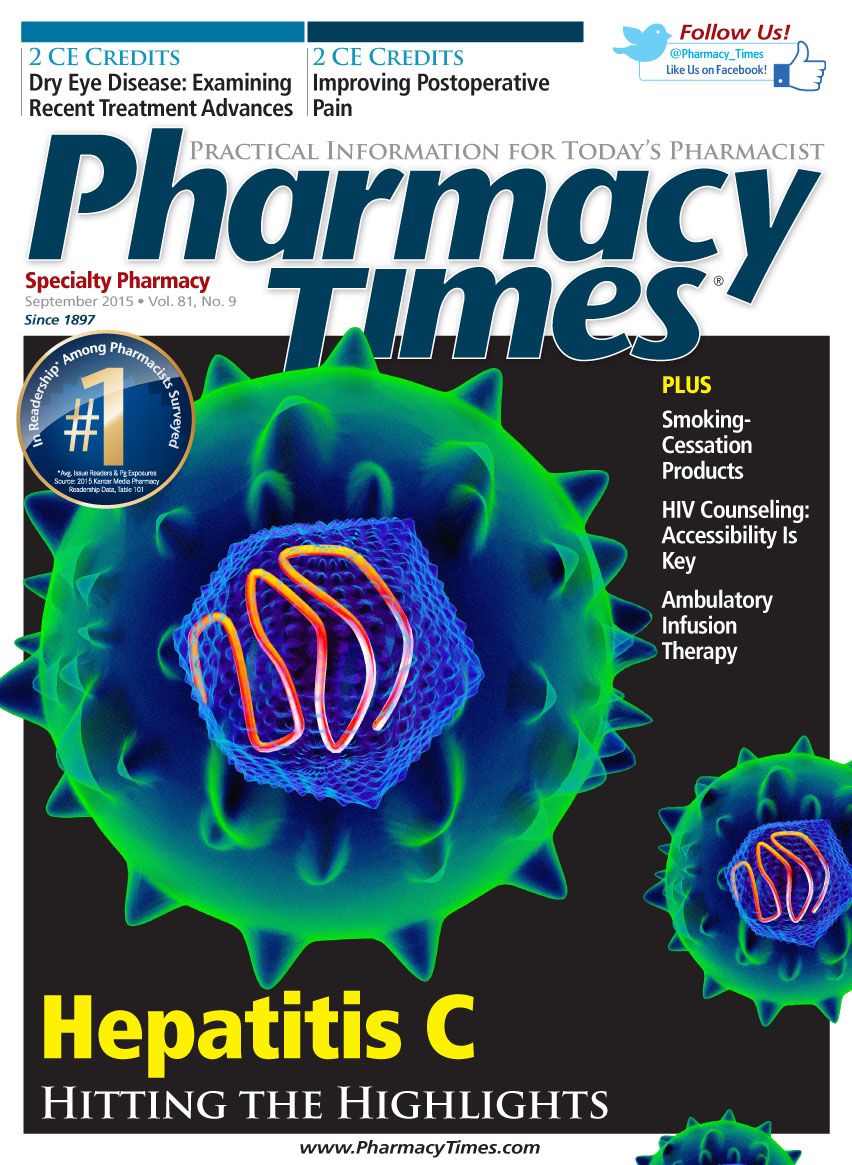Publication
Article
Pharmacy Times
Hepatitis C: Hitting the Highlights
Author(s):
Pharmacists are ideally situated to help patients beat hepatitis C.
Hepatitis C virus (HCV), a bloodborne pathogen, manifests itself as 2 kinds of infection: acute or chronic. Usually asymptomatic, an acute infection is rarely life threatening: about 15% to 45% of infected individuals spontaneously clear the virus within 6 months without treatment. Individuals, however, who do not clear the virus develop chronic HCV infection, and close to 45% of these patients eventually develop cirrhosis. Globally, between 130 and 150 million individuals have chronic HCV infection—a staggering number. In addition, approximately 500,000 people die of HCV-related liver disease annually.1,2 Pharmacists are ideally situated to help patients beat this infection. Let’s hit the highlights.
Pharmacists’ HCV Competence
Pharmacists need to know some basics about HCV treatments to be fundamentally competent when helping patients who have the disease. Treating HCV, like treating HIV and/or AIDS, is a complex challenge usually handled by specialists. Pharmacists’ minimum competencies should include the following:
- Knowing new protease inhibitors’ adverse effect (AE) profiles
- Recognizing the extensive lists of drug interactions
- Addressing the tendency for nonadherence due to high pill burden, dosing frequency, and AEs
- Anticipating cost concerns
Many HCV clinics provide teaching for patients in 45- to 60-minute sessions that often cover proper handling, storage, administration, AEs, drug interactions, and refill instructions. It is a lot for patients to remember, so they need clear labeling and reinforced counseling when they pick up prescriptions. Patients also need adherence support, which might include medication administration tracking forms, timers, and dose organizers.3
When pharmacists reinforce the health care team’s counseling, patients recognize them as information experts and will be more likely to seek subsequent counsel from the pharmacist. Patients who have chronic illnesses may find erroneous advice on the Internet or wonder if complementary or alternative medicines could cure them. Pharmacists must be honest if patients who have HCV inquire about ineffective or potentially hazardous products.3
At every visit, pharmacists should check for drug interactions thoroughly, especially if protease inhibitors are prescribed. The attending physician needs to be notified immediately if the patient’s drug regimen changes and interactions are likely. Pharmacists should also ask patients if they are experiencing any AEs.3
HCV Management: Changing, Improving
Before May 2011, clinicians’ sole option to treat a chronic HCV infection was weekly subcutaneous peginterferon alfa paired with twice-daily oral ribavirin. The peginterferon boosted systemic immunity and the ribavirin inhibited viral replication.4 Patients needed 24 to 48 weeks of treatment. After dealing with grave AEs, not all patients achieved sustained virologic response, defined as an undetectable viral load (ie, HCV ribonucleic acid) 24 weeks following treatment completion.5-7
Although the combination of interferon/ ribavirin is still used, in May 2011, the HCV landscape changed when the FDA approved 2 directly acting protease inhibitors, boceprevir and telaprevir, for genotype 1 HCV infection.8,9 The new standard of care for treatment-naïve patients with genotype 1 HCV infection or for patients who failed previous treatment with interferon thus became triple drug therapy.10 Peginterferon alfa and ribavirin became the “backbone,” and clinicians selected one of the protease inhibitors based on the patient’s characteristics.
Today, additional drugs are available and some patients can be treated with oral agents alone (Online Table 18,9,11,13-16). In fact, boceprevir and telaprevir are no longer recommended because sofosbuvir- or simeprevir-containing regimens are more effective.11 Telaprevir has been taken off the market.12 Some patients will still need interferon, however.11
Table 1: Agents Used to Treat Hepatitis C Virus Infection
Agent
Special Notes
Boceprevir*
- Compared with patients taking peginterferon alfa/ribavirin alone, patients taking boceprevir are more likely to experience anemia that manifests as fatigue, dyspnea on exertion, and shortness of breath
- To decrease AEs, reduce the dose or add erythropoietin
- Can cause taste disturbances
- Potent CYP450-3A4 inhibitor
- Dosed every 7-9 hours;
- Effective against genotype 1 only
Ledipasvir/sofosbuvir (Harvoni)
- Common AEs: fatigue or headache
- Do not administer with amiodarone or P-glycoprotein inducers
Ombitasvir/paritaprevir/ritonavir and dasabuvir (Viekira Pak)*
- Common AEs: dyspepsia or insomnia
- Monitor liver enzymes
- Patients must report skin irritation, severe asthenia, or signs of Stevens-Johnson syndrome/toxic epidermal necrolysis immediately
Peginterferon alfa-2a*
- Administer subcutaneously once weekly
- Common AEs: flu-like symptoms, nausea, diarrhea, dyspepsia, lack of appetite, skin irritation, alopecia, insomnia, headache, myalgia, arthralgia, dysgeusia, xerostomia, or injection-site irritation
- This product may cause numerous serious AEs
Ribavirin
- Never used as monotherapy
- May worsen cardiac disease
- Common AEs: anemia, sore throat, cough, shortness of breath, rash
Simeprevir
- Effective against genotype 1 only
- Common AEs: dyspepsia, sun sensitivity, itching, myalgia
- Patients must report dyspnea, severe skin irritation, stomatitis, or eye irritation immediately
Sofosbuvir
- Effective for any genotype
- Not effective as monotherapy
- Common AEs: headache, dyspepsia, nausea, insomnia
- Patients must report depression, suicidal ideation, anxiety, emotional instability, illogical thinking, dyspnea, severe asthenia, or pallor immediately
AEs = adverse effects.*Requires FDA-approved medication guides.Adapted from references 8, 9, 11, and 13-16.

Today, it is possible to use 2 direct-acting oral antiviral agents to treat HCV. In November 2014, the FDA approved an all-oral regimen of simeprevir plus sofosbuvir for treatment-naïve or treatment-experienced patients. This represents a milestone for HCV treatment: patients without cirrhosis can be treated for 12 weeks and patients with cirrhosis, 24 weeks. Treatment regimens are chosen based, in large part, on HCV genotype, subtype (1a or 1b, or 2 through 6), treatment history (naïve vs treatment failure), hepatic status, comorbidities, and concurrent medication. Patients’ responses to HCV treatment vary. Patients who have high viral loads, use alcohol, have longer duration of infection, or have HIV coinfection tend to respond less positively than those who do not.11 Table 211 describes treatment goals.
Also in 2014, the American Association for the Study of Liver Diseases and the Infectious Diseases Society of America, in collaboration with the International Antiviral Society- USA, joined together to create a centralized location to find information about hepatitis C. The site, HCVguidelines. org, is a frequently updated information treasure trove.11
End Note
HCV is worrisome for patients, and finances are often a primary concern. Most payers require prior authorization before starting agents used to treat HCV infection. Pharmacists can help manage patients’ worries by warning them about when to expect approval (or disapproval), potential out-of-pocket costs, and patient assistance programs.17
Ms. Wick is a visiting professor at the University of Connecticut School of Pharmacy.
References
- Hepatitis C. World Health Organization website. www.who.int/mediacentre/factsheets/fs164/en/. Updated April 2014. Accessed June 2, 2015.
- Davis GL, Alter MJ, El-Serag H, Poynard T, Jennings LW. Aging of hepatitis C virus (HCV)-infected persons in the United States: a multiple cohort model of HCV prevalence and disease progression. Gastroenterology. 2010;138(2):513-521. doi: 10.1053/j.gastro.2009.09.067.
- Spooner LM. The expanding role of the pharmacist in the management of hepatitis C infection. J Manag Care Pharm. 2011;17(9):709-712.
- Ghany MG, Strader DB, Thomas DL, Seeff LB; American Association for the Study of Liver Diseases. Diagnosis, management, and treatment of hepatitis C: an update. Hepatology. 2009;49(4):1335-1374. doi: 10.1002/hep.22759.
- Manns MP, McHutchison JG, Gordon SC, et al. Peginterferon alfa-2b plus ribavirin compared with interferon alfa-2b plus ribavirin for initial treatment of chronic hepatitis C: a randomised trial. Lancet. 2001;358(9286):958-965.
- Fried MW, Shiffman ML, Reddy KR, et al. Peginterferon alfa-2a plus ribavirin for chronic hepatitis C virus infection. N Engl J Med. 2002;347(13):975-982.
- Hadziyannis SJ, Sette H Jr, Morgan TR, et al; PEGASYS International Study Group. Peginterferon-alpha2a and ribavirin combination therapy in chronic hepatitis C: a randomized study of treatment duration and ribavirin dose. Ann Intern Med. 2004;140(5):346-355.
- Victrelis (boceprevir) [prescribing information]. Whitehouse Station, NJ: Merck & Co Inc; 2011. www.merck.com/product/usa/pi_circulars/v/victrelis/victrelis_pi.pdf. Updated July 2014. Accessed June 2, 2015.
- Incivek (telaprevir) [prescribing information]. Cambridge, MA: Vertex; 2011. www.accessdata.fda.gov/drugsatfda_docs/label/2011/201917lbl.pdf. Accessed June 2, 2015.
- Ghany MG, Nelson DR, Strader DB, Thomas DL, Seeff LB; American Association for Study of Liver Diseases. An update on treatment of genotype 1 chronic hepatitis C virus infection: 2011 practice guideline by the American Association for the Study of Liver Diseases. Hepatology. 2011;54(4):1433-1444. doi: 10.1002/hep.24641.
- Recommendations for testing, managing, and treating hepatitis C. Infectious Diseases Society of America and American Association for the Study of Liver Diseases website. http://hcvguidelines.org/full-report-view. Updated 2015. Accessed June 1, 2015.
- Weisman R. Vertex to stop selling hepatitis C drug Incivek. Boston Globe. August 12, 2014.
- Harvoni (ledipasvir and sofosbuvir) tablets [prescribing information]. Whitehouse Station, NJ: Merck & Co Inc; 2014. www.gilead.com/~/media/Files/pdfs/medicines/liver-disease/harvoni/harvoni_pi.pdf. Updated March 2015. Accessed June 11, 2015.
- Viekira Pak (ombitasvir, paritaprevir, and ritonavir tablets; dasabuvir tablets) [prescribing information]. North Chicago, IL: AbbVie Inc; 2014. www.rxabbvie.com/pdf/viekirapak_pi.pdf. Updated March 2015. Accessed June 11, 2015.
- Pegasys (peginterferon alfa-2a) [prescribing information]. South San Francisco, CA: Genentech USA Inc; 2002. www.gene.com/download/pdf/pegasys_prescribing.pdf. Updated March 2015. Accessed June 11, 2015.
- Copegus (ribavirin) [prescribing information]. South San Francisco, CA: Genentech USA Inc; 2002. www.gene.com/download/pdf/copegus_prescribing.pdf. Updated February 2013. Accessed June 11, 2015.
- Sovaldi (sofosbuvir) [prescribing information]. Foster City, CA: Gilead Sciences Inc; 2013. www.accessdata.fda.gov/drugsatfda_docs/label/2015/204671s004lbl.pdf. Updated March 2015. Accessed June 11, 2015.
- Olysio (simeprevir) [prescribing information]. Titusville NJ: Janssen Therapeutics; 2013. www.olysio.com/shared/product/olysio/prescribing-information.pdf. Updated April 2015. Accessed June 11, 2015.
- Tungol A, Rademacher KA, Schafer JA. Formulary management of the protease inhibitors boceprevir and telaprevir for chronic hepatitis C virus. J Manag Care Pharm. 2011;17(9):685-694.







